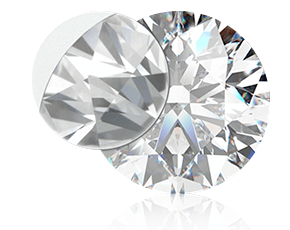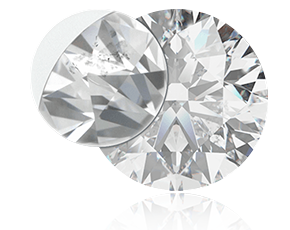The 4 Cs Of Diamonds: Cut, Clarity, Color, & Carat

The 4 Cs, as they are known within the jewelry industry, are the standard way to measure the beauty, craftsmanship, and value of a diamond.
#1 Cut
The term “diamond cut” refers to the quality of a diamond’s proportions and symmetry. These elements determine how much light a diamond captures and reflects, and therefore how much it sparkles. This is a direct result of the skill of the craftsman who shaped and cut the diamond.
There are four grades of diamond cut: Ideal, Very Good, Good and Poor.
If you compare two diamonds of different cuts grades, you will see that the higher cut grade has significantly more sparkle. There will also be a difference in their prices, with the better cut grade commanding a higher price. Of the 4 Cs, cut is generally recognized as the most important, since it has the greatest impact on a diamond’s appearance and quality.




Poor Cut
Will not sparkle very much. Unsatisfactory polish and symmetry.
Ritani does not carry poor diamonds.
Put Priority on Cut Grade
Given that cut has the most impact on a diamond’s overall appearance, we recommend you put the greatest priority on finding a high-quality cut grade. The diamond’s clarity and color should be considered secondary. We do not recommend purchasing a larger (higher carat) diamond if it means sacrificing the quality of the cut.
Round vs Fancy Shaped Diamonds
All diamonds that are not the classic round shape are categorized as “fancy shapes”. Due to the alignment of its facets, only a classic round diamond can earn the Ideal cut grade. This is not to say fancy-shaped diamonds are less desirable — far from it. They are graded differently though; if you are seeking a fancy diamond shape such as princess, cushion or radiant, the cut grades to look for are Very Good.

Buying tip: Since fancy shapes don't receive an official cut grade from the GIA, make sure to choose a fancy-shaped diamond with Excellent polish and Excellent symmetry grades.
#2 Clarity
Clarity refers to a diamond’s natural inclusions, or lack thereof. While small marks within a diamond are natural, their appearance can leave something to be desired if they are visible to the unaided eye.
The shape of a diamond can affect the importance of its clarity grade. The facet patterns of the brilliant-cut diamond shapes such as round and princess can hide certain imperfections, but step-cut shapes such as emerald and Asscher have large, open tables that make inclusions more obvious.
The lowest clarity grade within the Ritani diamond inventory is SI2. These diamonds may have small visible inclusions. If you are searching for a step-cut diamond, we suggest a minimum clarity grade of VS2.
If you want to rest assured that your diamond will display a clean and stunning brilliance, a clarity grade of VVS2 or higher is recommended for all diamond shapes.

Flawless (FL)
No surface imperfections or inclusions; the rarest of all diamonds.

Internally Flawless (IF)
No visible inclusions, even under magnification.

Very Very Slightly Included 1 (VVS1)
No imperfections visible to the unaided eye.

Very Very Slight Included 2 (VVS2)

Very Slightly Included 1 (VS1)
At VS1, you may be able to see a few tiny imperfections upon close inspection.

Very Slightly Included 2 (VS2)
At VS2, you might be able to see a few more tiny inclusions.

Slightly Included 1 (SI1)
Imperfections, though small, are likely to be visible with the unaided eye.

Slightly Included 2 (SI2)
Imperfections, though small, are likely to be visible with the unaided eye.
#3 Color
Though it may seem counterintuitive, a diamond’s color grade actually measures how little color it reflects.
The diamond color grading scale begins with “D” and ranges down to “Z”. A diamond assigned a grade of “D” has absolutely no color -- it looks pure white, even to a gemologist inspecting it carefully under 10X magnification. On the other hand, a diamond assigned a grade of “Z” looks yellow or brownish.

Colorless (D, E, F): Pairs well with platinum, palladium, and white gold.
Near-Colorless (G, H, I, J): Pairs well with white, yellow, or rose gold.
Noticeable Color (K, L): Pairs well with yellow gold or rose gold.

Buying Tip:
While diamonds in the “colorless” category reflect the purest white light, it is hard for most consumers to see any color in the “near-colorless” category. That’s why a “near-colorless” diamond is a safe bet if you plan to set it in yellow or rose gold jewelry, since the warm color of the metal makes any yellowness in the diamond less noticeable. But if you want the purest white diamond, select one that’s “colorless” and set it in white gold or platinum.
#4 Carat
Carat is the measure of how much a diamond weighs. Carat is also related to size (how big a diamond looks), although it’s not the only factor that determines size. Depending on shape, weight distribution and cut quality, two diamonds with the same carat weight can be different sizes.
It’s worth noting that some diamonds are cut solely with an emphasis on weight. These gems can sacrifice brilliance and symmetry in favor of delivering a larger carat figure. At Ritani, we recommend seeking a balance between cut and carat weight in order to ensure a symmetrical, brilliantly sparkling diamond.

.25CT - Focus on finding a cut grade of Very Good or Ideal for a brilliantly sparkling diamond.
.50CT - Inclusions will be difficult to see in a 0.50 carat diamond, so lower the clarity grade and focus on getting the best color and cut grade within your budget.
.75CT - At this size, any visible inclusions will be less noticeable, so you can afford to go for a lower clarity grade such as SI1 or SI2. Seek a cut grade of Very Good or Ideal.
1CT - If you’re looking for a solitaire engagement ring, focus on Ideal cut with Excellent polish and symmetry grades. If you’re pairing with side stones or a halo, focus on higher color and clarity grades.
1.25CT - If shopping for a diamond 1.25 carats or larger, opt for VS2 clarity or better, since inclusions are more noticeable in larger diamonds.
1.5CT - As an above-average purchase price, focus on mid-range color and clarity while maximizing cut grade.
2CT - Some SI inclusions will be visible with the unaided eye, so avoid anything less than VS1 clarity.
3CT - The larger size magnifies any natural inclusions, so if choosing a diamond lower than VS1 clarity grade, make sure it is eye-clean. Avoid any diamonds with fluorescence in this carat range and above.
4CT - Approaching the ultra-luxe, look for diamonds whose natural inclusions are on the pavilion side of the diamond, where they will be less noticeable.
5CT - The ultimate in luxury; go for the Triple X: Excellent polish, Excellent symmetry and Excellent cut.
Choosing Your Carat Weight
When you’re ready to choose a carat weight for your diamond, remember that size is not everything – cut grade strongly affects the quality and beauty of your diamond; color and clarity grades do so too (though to a lesser degree).
For the best value, consider diamonds slightly lighter than the carat weight you initially had in mind. For example, if you are thinking about purchasing a 1-carat diamond, consider diamonds at 0.95 to 0.99 carats as well. The difference in visual size will be negligible, but the savings can be significant. You can use those savings to invest in a higher cut grade or a more lavish ring setting.

Buying Tip: Every diamond within Ritani’s inventory is listed with its 4 C specifications as well as polish, symmetry and fluorescence details within its profile.
Learn more in our Ultimate Diamond Buying Guide.


